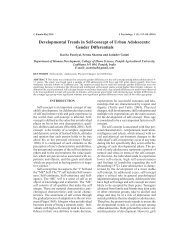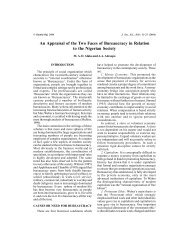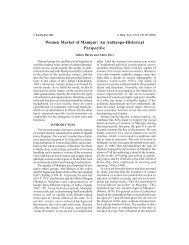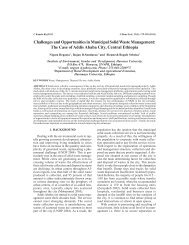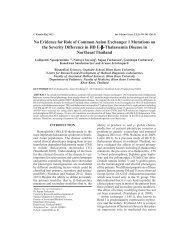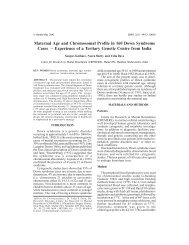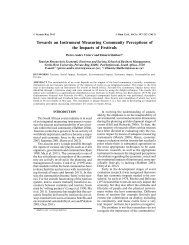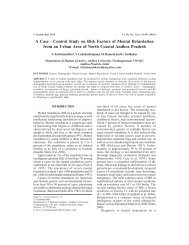Microdeletion Syndromes Detected by FISH - Kamla-Raj Enterprises
Microdeletion Syndromes Detected by FISH - Kamla-Raj Enterprises
Microdeletion Syndromes Detected by FISH - Kamla-Raj Enterprises
You also want an ePaper? Increase the reach of your titles
YUMPU automatically turns print PDFs into web optimized ePapers that Google loves.
16<br />
dation, obesity with increasing age, hypogonadism,<br />
small hands and feet, fair hair and skin.<br />
These children have a habit of excessive skin<br />
picking. (Robinson et al. 1991; Cassidy et al.<br />
1992).<br />
Angelman Syndrome (AS)<br />
This is also known as Happy Puppet syndrome.<br />
The children in general have a happy<br />
predisposition with outbursts of laughter often<br />
accompanied <strong>by</strong> frequent hand flapping. These<br />
children have mental retardation with microcephaly,<br />
jerky movements affecting the trunk and<br />
upper limbs, ataxia, unsteady and wide-based<br />
gait, wide mouth with constant dribbling and<br />
prominent chin (Boyd et al. 1988; Clayton-Smith<br />
1992).<br />
In a majority of cases, both the above clinically<br />
different syndromes are caused <strong>by</strong> the same<br />
microdeletion +/- 4 Mb on chromosome 15 at the<br />
15q11-13 region. Because of imprinting, the<br />
presence of a microdeletion on the paternal<br />
chromosome 15 leads to Prader-Willi syndrome,<br />
while a microdeletion on the maternal chromosome<br />
15 causes Angelman syndrome (Wagstaff<br />
et al. 1992). Besides micordeletions and<br />
imprinting, uniparental disomy and intragenic<br />
mutations can also cause the two syndromes<br />
(Malcolm et al. 1991).<br />
Williams Syndrome (Williams-Beuren<br />
Syndrome) - (WS)<br />
This is caused <strong>by</strong> a microdeletion on<br />
chromosome 7 at the Elastin locus 7q11 (Ewart et<br />
al. 1993). The facial features consist of a medial<br />
eyebrow flare, a stellate iris pattern, flat nose<br />
bridge and long smooth philtrum with widely<br />
spaced teeth. The characteristic heart defect is a<br />
supravalvular aortic stenosis (Burn 1986;<br />
Halladie-Smith and Karas 1988; Jones 1990).<br />
DiGeorge Syndrome (Velocardiofacial<br />
Syndrome or CATCH 22) – (DS)<br />
The chromosomal microdeletion is at 22q11.<br />
The clinical features include hypoplasia, hypoparathyroidism<br />
and cardiac malformations. Dysmorphic<br />
features include hypertelorism, low-set<br />
ears and micrognathia. The most common cardiac<br />
defects include interrupted aortic arch, often with<br />
VSD (Ventricular Septal Defect) and a persistent<br />
PROCHI F. MADON, ARUNDHATI S. ATHALYE ET AL.<br />
truncus arteriosus (Driscoll et al. 1992; Laena-<br />
Cox et al. 1996; Scambler et al. 1992). It is also<br />
called CATCH 22 because it describes the<br />
abnormal findings of cardiac anomalies, abnormal<br />
facies, thymic hypoplasia, cleft palate and<br />
hypocalcemia due to a deletion on chromosome<br />
22.<br />
<strong>FISH</strong> Probes and Interpretation<br />
<strong>Microdeletion</strong> probes have control signals<br />
on the same chromosome, which can clearly be<br />
seen on metaphases. For Williams and DiGeorge<br />
syndromes, the control signals are labeled in<br />
green (G) and the critical region with orange (O)<br />
in the present study. Therefore a normal cell will<br />
show a 2G2O pattern whereas a cell with the<br />
deletion will show a 2G1O pattern (Fig. 1a, b).<br />
The SNRPN probe for detection of PW/AS has<br />
got two internal controls, a large proximal green<br />
signal (CEP 15) and a smaller orange signal (PML)<br />
towards the distal end. The critical region<br />
(SNRPN) has a small orange signal and lies<br />
between the two control signals on chromosome<br />
15, adjacent to the green signal. With this probe,<br />
normal cells show a 2G4O signal pattern whereas<br />
cells with the microdeletion show a 2G3O signal<br />
pattern (Baumer et al.1999) (Fig. 1c, d). <strong>FISH</strong><br />
signals on metaphases should be checked with<br />
this probe to avoid false positive results due to<br />
deletion of the control orange signal. The D15S11<br />
probe for PW/AS is used to double check such<br />
cases as it has only 1 internal control region in<br />
green.<br />
MATERIAL AND METHODS<br />
Over the past 5 years, a total of 374 blood<br />
samples of patients referred <strong>by</strong> pediatricians<br />
across the country were tested for microdeletions<br />
at Jaslok Hospital. PHA stimulated 72 hour whole<br />
blood cultures were set up to obtain metaphases<br />
using standard techniques. Fixed WBC pellets<br />
of blood cultures were also accepted from other<br />
laboratories. <strong>FISH</strong> was carried out using Vysis<br />
(Abbott) probes <strong>by</strong> codenaturation of the probe<br />
with the test sample at 73 o C for 5 minutes, followed<br />
<strong>by</strong> overnight hybridization at 37 o C. After<br />
washing as per the manufacturer’s protocol, the<br />
slides were mounted in the counter-stain DAPI<br />
and observed under a Zeiss fluorescent microscope.<br />
The images were captured and processed<br />
with Metasystems isis software. About 100-200







